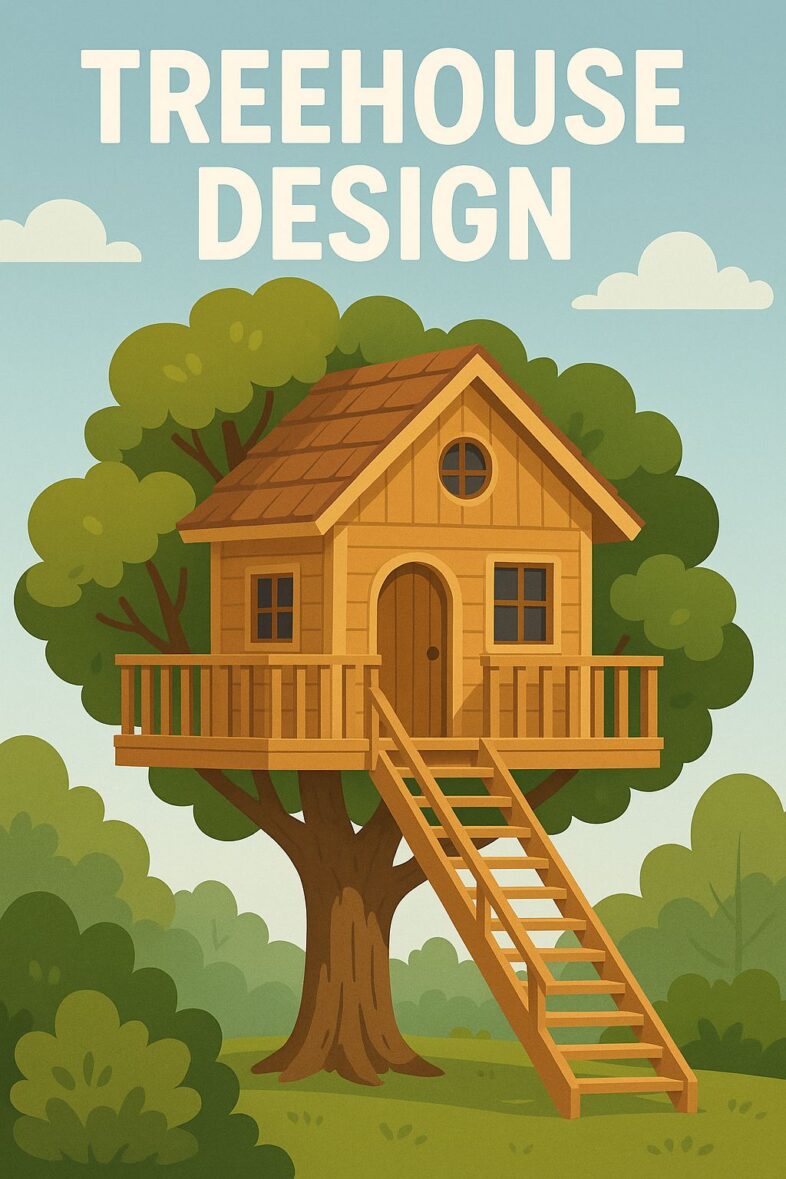Oak tree analysis for treehouse support can be as simple as for any treehouse construction support. Use standard triangular support structures with robust tree bolts like GTS Allstar screws, or consider flexible tree brace attachments with counter-bearings for stability on slanted trunks. But, read on if you want a deeper discussion of analysing an oak tree for its suitability as a treehouse support.
Key Takeaways
- Oak trees are among the best options for treehouse support due to their strength, stability, and extensive root systems that can be as deep as their branches are high.
- White oak trees offer superior strength and natural rot resistance, making them the gold standard for treehouse construction compared to red and live oak varieties.
- Proper tree assessment requires evaluating trunk diameter (minimum 12 inches for standard treehouses), branch structure, root health, and tree maturity (20+ years old).
- Warning signs that make an oak unsuitable include visible decay, fungal growth, canopy dieback, pest infestations, and leaning trunks that indicate potential instability.
- Treehouse Supplies provides specialised hardware and design consulting to ensure your oak tree treehouse project maintains both structural integrity and tree health.
The perfect treehouse begins with the perfect tree. When stability, longevity, and strength are your priorities, oak trees stand tall among the options available to ambitious builders. Their remarkable structural integrity and adaptability to various attachment methods make them the backbone of memorable, generational treehouses that can withstand decades of use and enjoyment.
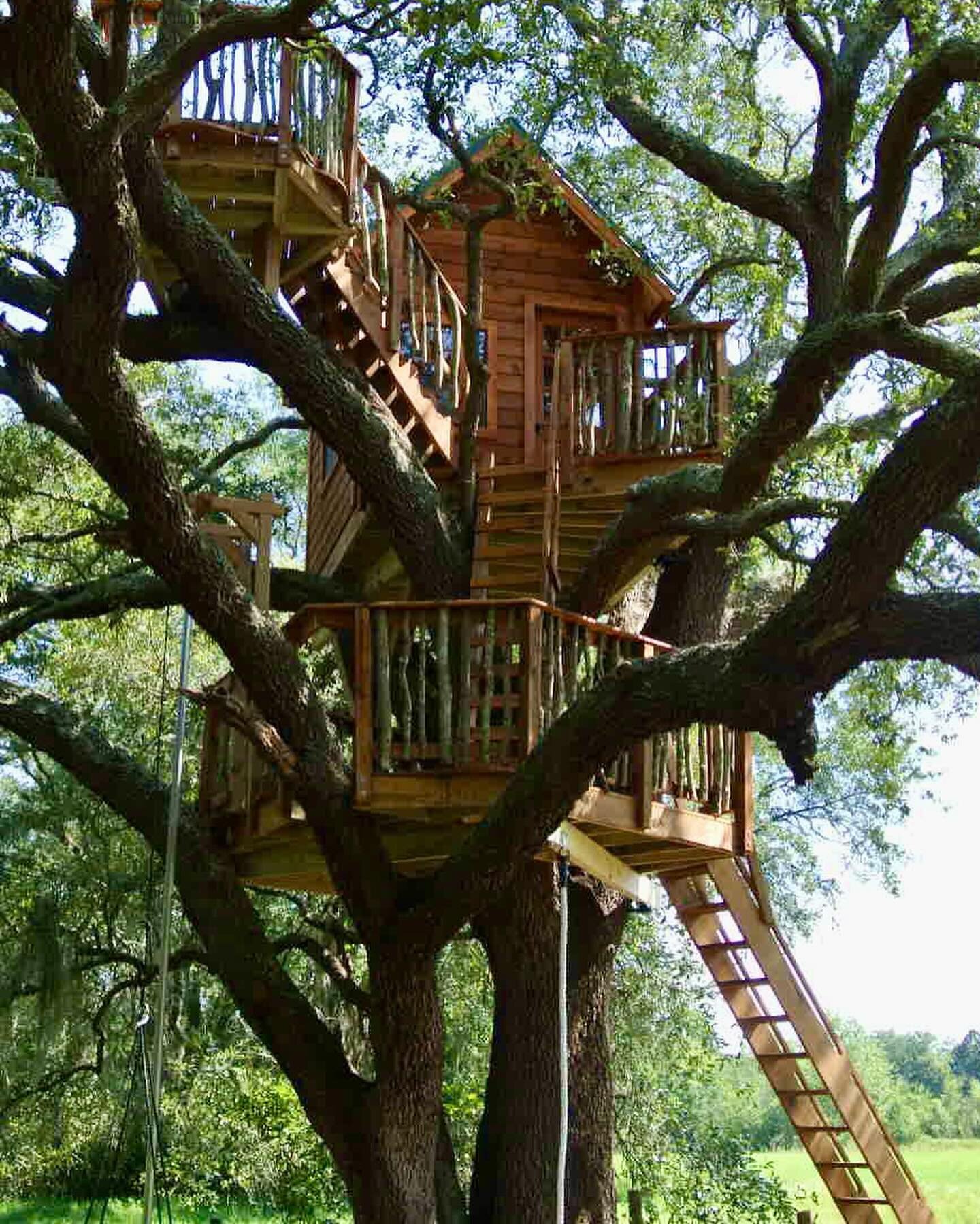
“Treehouse Experts LLC” from www.treehouseexperts.com and used with no modifications.
Before you drive in a single nail or attach a single beam, understanding the specific characteristics of your oak tree will determine the success of your entire project. Oak trees have supported human structures for centuries, but each tree presents a unique set of opportunities and challenges that require careful analysis.
Treehouse Supplies has helped thousands of builders evaluate and properly utilize oak trees for structural support, providing both the hardware and knowledge needed to create harmonious relationships between architecture and nature. The right approach preserves both the tree's health and your treehouse's stability for generations to come.
Check Current PriceWhy Oak Trees Make Ideal Treehouse Supports
Oak trees possess a rare combination of qualities that make them exceptional candidates for supporting treehouses. Their dense wood fibre creates a natural strength that few other species can match, allowing them to bear significant weight without compromising structural integrity. This density also provides superior holding power for fasteners, ensuring your attachment points remain secure through years of wind, weather, and use.
The root systems of mature oaks are particularly impressive, often extending underground to almost the same distance as their branches reach skyward. This extensive anchoring provides remarkable stability during storms and high winds, a crucial factor when human occupancy is involved.
Unlike many fast-growing species that may reach impressive heights quickly but lack internal strength, oaks grow slowly and develop robust cellular structures with each passing year. For those interested in understanding the balance between rapid growth and structural integrity, a comparative analysis of different species can be enlightening.
Perhaps most valuable is the oak's natural resistance to decay and disease when properly maintained. While no tree is immune to health challenges, oaks typically demonstrate exceptional resilience when attachment points are properly installed and maintained.
Their natural tannins provide some protection against insects and fungal invasion at attachment points, giving builders a longer window of structural dependability compared to many other species.

“Best Trees for Building a Treehouse …” from aunlimitedtreellc.com and used with no modifications.
Oak Tree Species Best Suited for Treehouses
Not all oak trees offer equal potential for treehouse construction. Understanding the specific characteristics of different oak species can help you maximise both structural integrity and tree health throughout your project's lifespan. For more insights on choosing the right tree, check out this guide to selecting a tree for a treehouse.
White Oak: The Gold Standard
White oak (Quercus alba) represents the premier choice for treehouse construction across most of North America. These magnificent trees combine exceptional strength with natural rot resistance that surpasses virtually all other oak varieties.
Their cellular structure includes tyloses – microscopic structures that plug the wood's vessels and create a naturally water-resistant material. This biological feature significantly reduces moisture penetration at attachment points, minimising decay around hardware.
The growth pattern of white oaks typically produces a more symmetrical, balanced branch structure compared to other varieties, offering multiple potential attachment points that distribute weight evenly.
Their branches also tend to grow at angles that naturally resist tearing under load. White oaks generally reach maturity more slowly than red oaks, but this measured growth creates denser wood with superior load-bearing capacity, making the wait worthwhile for serious treehouse builders.
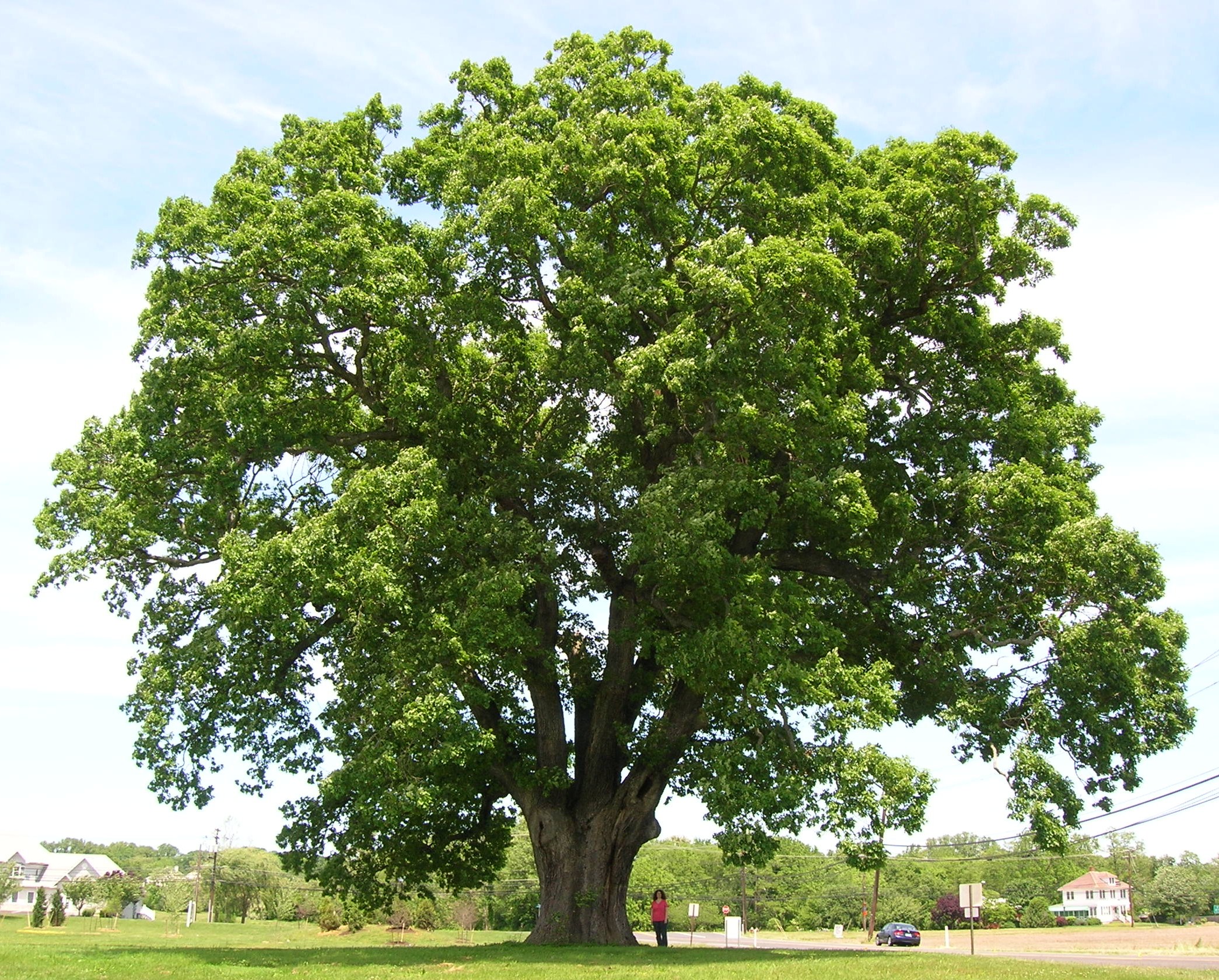
“Quercus alba – Wikipedia” from en.wikipedia.org and used with no modifications.
Check Current PriceRed Oak: Strong But Requires Special Attention
Red oak species (Quercus rubra and relatives) offer excellent strength characteristics but demand more careful installation and maintenance practices than their white oak cousins.
The most significant difference lies in their porosity – red oaks have open cellular structures that allow moisture to penetrate more deeply, potentially accelerating decay around attachment points. This characteristic doesn't disqualify red oaks from consideration, but it does necessitate more thorough waterproofing of all hardware connections.
The growth habit of red oaks often produces more aggressive vertical reach with slightly less lateral branch spread in many specimens. This can sometimes limit optimal attachment point options, but provides excellent height potential for multi-level designs.
Red oaks typically grow faster than white oaks, which creates slightly less dense wood but may provide usable size sooner for impatient builders.
When working with red oak, specialised hardware like through-bolted attachment systems with proper waterproofing compounds becomes particularly important. The investment in premium, waterproof attachment methods pays significant dividends in extending the structural lifespan of your treehouse when using red oak as your foundation.
For more details on how to choose the right tree for your treehouse, visit this guide on selecting trees.
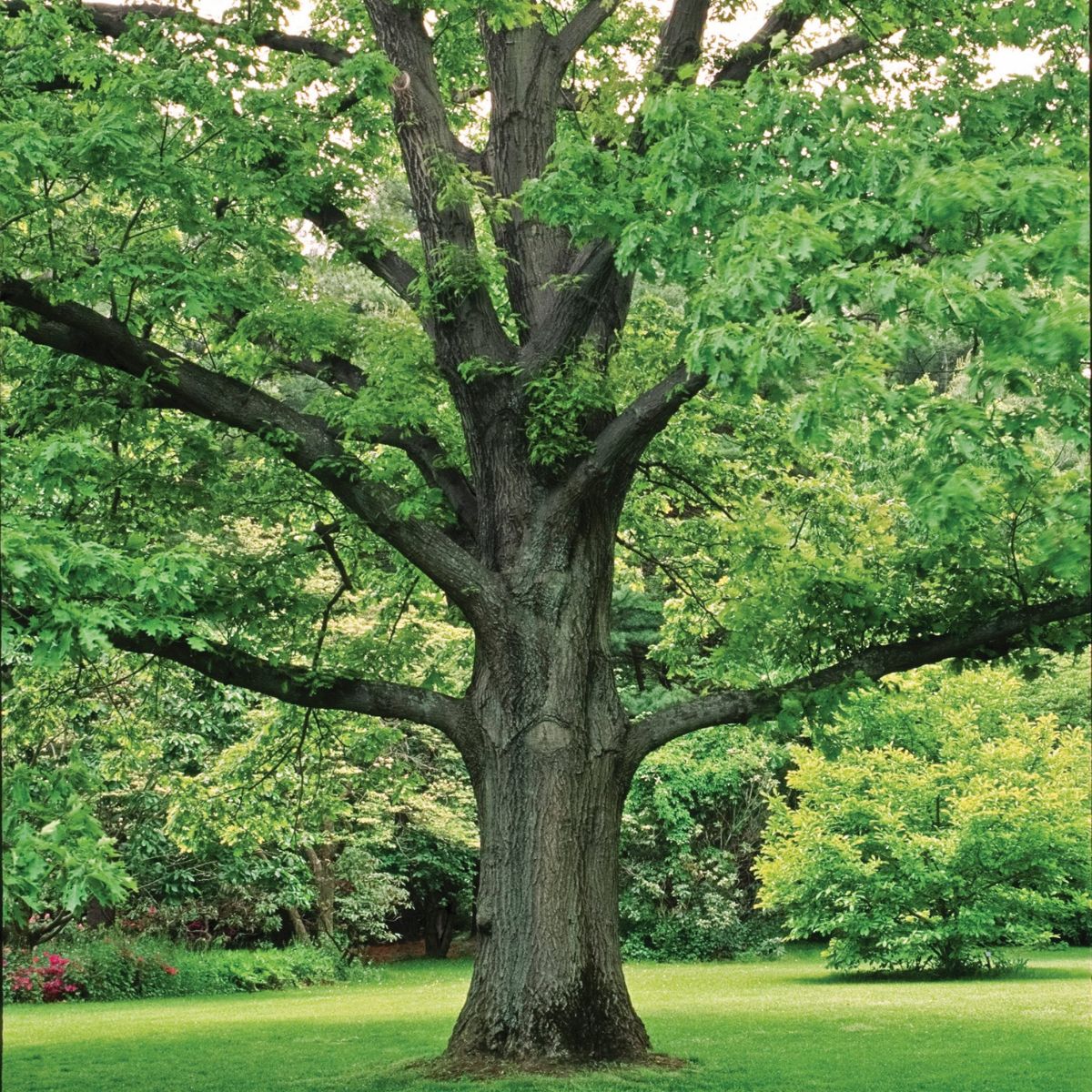
“Northern Red Oak Trees for Sale at …” from shop.arborday.org and used with no modifications.
Check Current PriceOak Species Comparison for Treehouse Support
Treehouse Support Characteristic White Oak Red Oak Live Oak Decay Resistance Excellent Moderate Very Good Growth Pattern Balanced, symmetrical Vertical emphasis Wide, horizontal spread Fastener Holding Power Superior Very Good Excellent Weight Capacity Highest High Very High Maintenance Requirements Low Moderate Low
Live Oak: Exceptional for Treehouse Support in Warmer Climates
For builders in southern regions, live oak (Quercus virginiana) offers perhaps the most dramatic architectural possibilities of any oak species.
These majestic trees are distinguished by their sprawling, horizontal growth habit, often producing massive limbs that extend nearly parallel to the ground – creating natural platforms that seem purpose-built for treehouse construction. Their natural structure frequently eliminates the need for artificial support posts, allowing for more organic integration between tree and structure.
For more insights on choosing the right tree, you can explore how to choose a tree for a treehouse.

“Quercus virginiana – Wikipedia” from en.wikipedia.org and used with no modifications.
Structural Red Flags to Avoid when Looking for Treehouse Support
When evaluating an oak tree for treehouse suitability, certain structural issues should immediately disqualify a tree from consideration. V-shaped crotches, where major branches meet the trunk, represent significant failure points as they lack the structural integrity of U-shaped unions.
These formations often contain included bark – bark that gets trapped between branches as they grow together – creating a weak point that can split apart under the additional weight of a treehouse.
Visible cracks, especially those extending vertically along the trunk, indicate internal structural compromise that may not be immediately apparent from the outside. These fractures often develop from previous storm damage, lightning strikes, or growth stress, and they create pathways for moisture and pathogens to penetrate deep into the heartwood.
A tree with these issues may appear stable under normal conditions, but could catastrophically fail when supporting the additional loads of a treehouse and its occupants.
Hollow sections, even those that appear minor from the outside, dramatically reduce a tree's structural capacity. Unlike engineered materials that can maintain strength with hollow cores, trees rely on their entire cross-section for treehouse support stability.
Even a 30% hollow area can reduce a tree's strength by over 70%, creating a dangerous situation for treehouse builders who might not realise the extent of internal decay.
Common Structural Defects in Oak Trees
Understanding the common structural defects in oak trees is essential for maintaining their health and longevity. These defects can lead to serious issues if not addressed in a timely manner. For a comprehensive guide on maintaining structural integrity, you might find this comparative guide on tools useful for addressing some of these defects.
Multiple leaders (co-dominant stems): When two or more main trunks grow with approximately equal diameter, they often create a weak attachment point susceptible to splitting.
For those interested in sustainable practices, incorporating recycled materials can be a great way to support environmental efforts.
Lean greater than 15°: Trees with significant lean indicate root plate issues and uneven weight distribution that will be exacerbated by a treehouse.
Previous large limb failures: These suggest internal structural weaknesses that may be present throughout the tree.
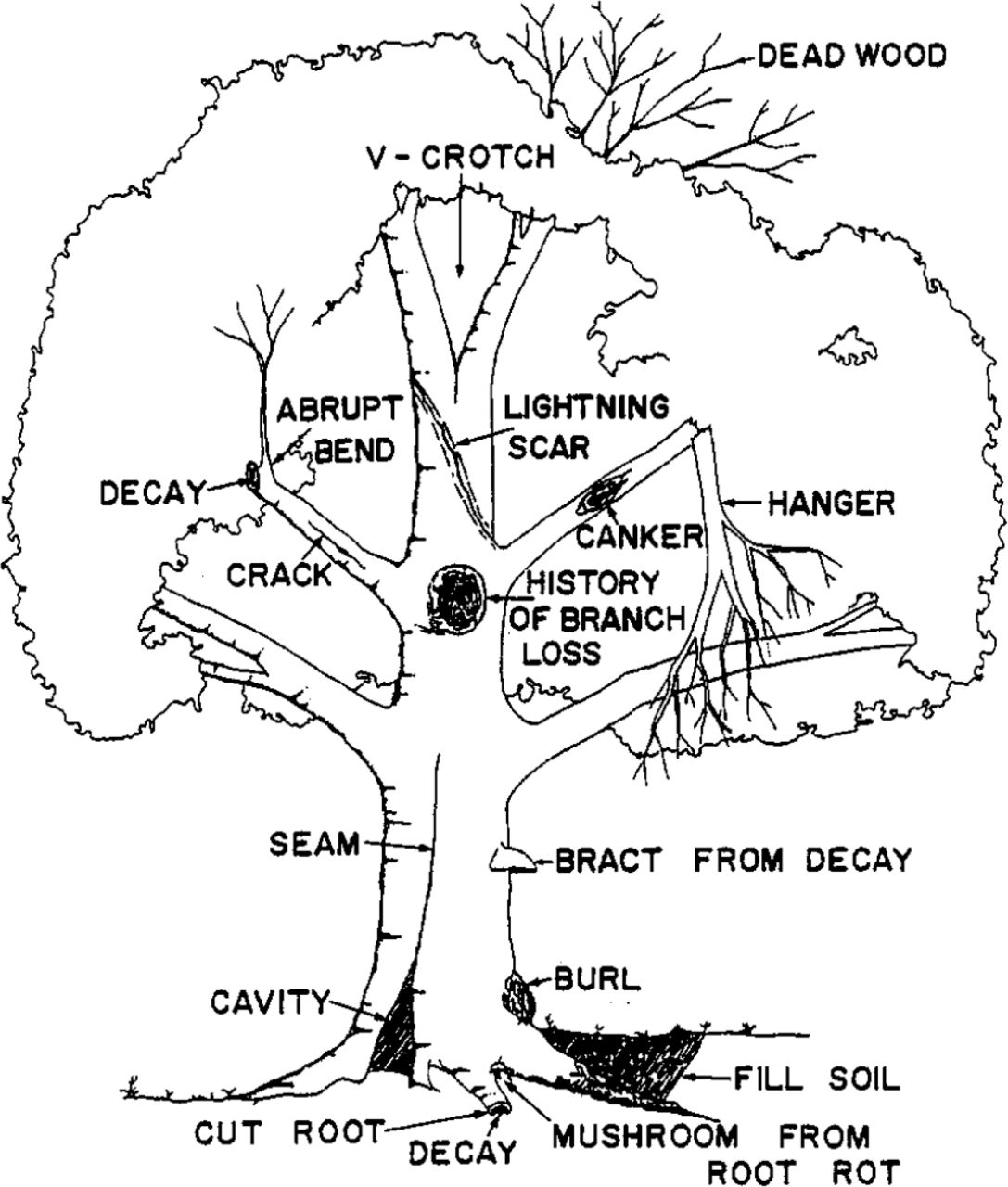
“Determining Strength Loss from Decay …” from auf.isa-arbor.com and used with no modifications.
Check Current PriceEnvironmental Stress Symptoms
Oak trees under environmental stress display subtle but critical warning signs that they cannot support additional weight. Thinning leaf density throughout the canopy, particularly when asymmetrical, indicates the tree is already struggling to sustain its own systems.
This reduced photosynthetic capacity means the tree has less energy for compartmentalising wounds and maintaining structural integrity – both crucial factors when supporting a treehouse.
Soil compaction around the critical root zone can severely compromise an oak's stability even when the tree appears healthy above ground.
Compacted soil reduces oxygen availability to roots, limits water penetration, and restricts the root system's ability to expand properly. Trees in areas with recent construction activity, heavy foot traffic, or that have been used for vehicle parking frequently suffer from this invisible but serious condition that dramatically reduces their load-bearing capacity.
| Environmental Stress Indicator | What It Means for Treehouse Suitability |
|---|---|
| Stunted leaf size | Tree is conserving resources; reduced ability to heal attachment wounds |
| Premature autumn colour | Tree is under significant stress; cannot support additional loads |
| Excessive deadwood in the upper canopy | Tree is self-pruning due to resource limitations; structurally compromised |
| Mushrooms/conks on trunk or major roots | Active decay is present; tree has significantly reduced structural integrity |
Water stress patterns present another crucial environmental consideration when selecting an oak for treehouse support. Trees in areas with fluctuating water tables or those experiencing extended drought periods develop survival mechanisms that prioritise the tree's core functions over structural growth. These adaptations often lead to brittle wood formation and reduced vascular function in outer branches – precisely where most treehouses attach.
Recently transplanted or severely pruned oaks (within 3-5 years) should also be avoided as treehouse candidates. These trees direct significant energy toward reestablishing balance between their root systems and canopies, making them particularly vulnerable to the additional stress of supporting structures.
Wait until the tree has fully recovered from these interventions before considering it for treehouse attachment, typically evidenced by at least three years of normal seasonal growth patterns.

“My neighbour has 2 severely pruned giant oak trees in …” from www.reddit.com and used with no modifications.
Load-Bearing Capacity of Oak Trees
Understanding an oak tree's load-bearing capacity requires balancing both biological and engineering principles. Unlike manufactured building materials with standardised strength ratings, trees are living systems with varying structural properties based on species, age, growth conditions, and health status.
This variability demands careful assessment rather than reliance on general guidelines.
The most critical factor in load capacity is trunk diameter – as a general rule, a healthy oak should have a minimum diameter of 12 inches measured at chest height to support even a modest treehouse. This measurement correlates with both the tree's maturity and its ability to develop the specialised reaction wood necessary to adapt to the concentrated loads a treehouse creates. Younger trees with smaller diameters may grow faster initially, but they lack the cellular density and developed root systems required for long-term support.
Branch selection plays an equally important role in determining support capacity. The strongest attachment points occur where branches connect directly to the main trunk rather than to other branches.
These primary connections have developed specialised tissues specifically designed to transfer forces efficiently through the tree's structure. Ideal support branches should be at least one-third the diameter of the main trunk and emerge from the trunk at angles between 45-90 degrees for optimal load distribution. For more information on selecting the right tree, you can read about how to choose a tree for a treehouse.
Weight Distribution Calculations
When calculating how much weight your oak can safely support, the distribution of that weight matters as much as the total load. Concentrating weight in a small area creates stress points that can exceed the tree's capacity even when the total weight seems reasonable.
The healthiest approach spreads attachment points across multiple branches or utilises a balanced design that distributes weight evenly around the trunk. For more insights, you might consider reading about choosing the right tree for a treehouse.
A professional formula for estimating preliminary load capacity suggests that a healthy mature oak can typically support approximately 4-8 pounds per square inch of its cross-sectional area at the smallest attachment point. This calculation provides a starting point but should be adjusted based on specific tree conditions and attachment methods. For safety, most experienced builders recommend designing to no more than 50% of this calculated capacity to account for dynamic loads from wind, movement, and multiple occupants (verify calculation before use).
- Calculate the cross-sectional area of your attachment branch (square inches)
- Multiply by a load factor (4-8 pounds per square inch for healthy oaks)
- Reduce by 50% for a safety margin
- Divide the total weight by the number of attachment points
- Ensure no single attachment exceeds the calculated safe load
Beyond mathematical calculations, context-specific factors significantly impact actual load capacity. Trees on slopes, those with asymmetrical canopies, or those in areas with regular high winds require more conservative loading estimates than those growing in protected, flat locations with balanced growth patterns.
The tree's history also matters – oaks that have previously adapted to stressors like ice storms or high winds have often developed specialised wood structures that can indicate either enhanced resilience or hidden weaknesses.
Maximum Safe Loading Guidelines
Establishing absolute maximum weight limits for oak tree treehouses requires balancing caution with practical reality. Most well-designed treehouses supported by mature, healthy oaks (24+ inches in diameter) can safely accommodate structures weighing 2,000-4,000 pounds when properly distributed across multiple attachment points.
This typically allows for a comfortable 10×12-foot structure with multiple occupants, basic furnishings, and standard safety features. However, this capacity assumes optimal attachment methods, regular professional inspections, and ongoing adjustments to accommodate the tree's growth and seasonal movement patterns.
Wind and Weather Impact Factors
Wind loading represents one of the most underestimated forces affecting treehouse stability in oak trees. While the tree itself has developed specialised tissues to flex and distribute wind forces throughout its structure, a treehouse creates an additional sail-like surface that captures wind energy.
This can increase the effective force on attachment points by 200-300% during moderate wind events. Successful designs account for this by incorporating flexible connections, aerodynamic profiles that minimise wind resistance, and strategic placement that utilises the tree's natural wind-shedding architecture to protect the structure during storms.
Check Current PriceAttachment Methods That Protect Your Oak
The interface between your treehouse and the oak tree supporting it represents the most critical aspect of your entire design. Traditional methods like nails and lag screws driven directly into the tree create injury pathways for pathogens and concentrate stress at single points, substantially reducing both tree health and structural safety. Modern attachment systems focus on distributing forces across broader areas while minimising tree damage through specialised hardware designed specifically for the unique challenges of living supports.
Tree-Friendly Fastening Systems
Treehouse attachment bolts (TABs) represent the current gold standard for oak tree attachments, providing a stable connection point that minimises tree damage while maximising load capacity. These specialised fasteners feature a shaft that extends completely through the trunk or branch, distributing weight across the entire cross-section rather than concentrating it at a single point.
The stem extends outward from the tree, providing a mounting point for beams that maintains a critical air gap between the wood structure and the living tree. This separation allows the tree to move naturally in the wind while preventing moisture trapping between surfaces – a common cause of accelerated decay in traditional attachment methods.
Support Bracket Selection and Placement
The optimal placement of support brackets on an oak tree requires understanding how forces travel through the tree's structure. The strongest attachment points occur just above branch collars – the slightly swollen areas where branches connect to larger limbs or the main trunk.
These areas contain specialised wood grain patterns that efficiently transfer loads while minimising stress concentrations.
Avoid placing attachments directly on branch bends or curves, as these areas are already managing significant internal stresses and have more complex grain patterns that may not efficiently distribute additional loads from your treehouse structure.
Techniques to Minimise Tree Damage
Beyond specialised hardware, proper installation techniques dramatically impact both tree health and attachment strength.
Drilling techniques matter significantly – using sharp, clean bits at appropriate speeds prevents excess tissue damage around the penetration point.
Drilling pilot holes slightly smaller than the final fastener allows the tree to compress around the hardware, creating a tighter seal that reduces moisture intrusion. Following installation, applying specialised tree-safe sealants to the outer edge of penetrations (but never inside the hole itself) provides an additional barrier against pathogens while still allowing the tree's natural compartmentalisation processes to function properly.
Growth Accommodation Strategies
Unlike building on static foundations, treehouse construction must accommodate a living, growing support system. Oak trees typically add 1/8″ to 1/4″ in diameter annually, which seems minimal but creates significant pressure on rigid attachment systems over time.
Without proper accommodation for this growth, attachments can either become embedded in the tree (causing severe health issues) or be pushed outward as the tree expands (compromising structural stability).
The critical principle in designing for growth is avoiding any closed loops around branches or trunks. Rigid bands, straps, or cables that completely encircle any part of the tree will eventually restrict vascular flow as the tree expands, potentially killing everything above the restriction point.
Even designs that initially provide “room to grow” will eventually cause damage if they create a fixed circumference that the tree cannot expand beyond.
Flexible Attachment Systems
Sliding bracket systems represent the most effective solution for accommodating oak tree growth while maintaining structural integrity. These specialised hardware components allow one dimension to remain fixed (typically the vertical support) while permitting horizontal movement as the tree expands in diameter.
The most sophisticated versions incorporate specially designed washers and spacers that reduce friction at movement points, ensuring the system continues to function smoothly over decades rather than binding up as traditional sliding mechanisms often do when exposed to outdoor conditions.
Annual Growth Adjustments
Successful treehouse designs incorporate annual adjustment mechanisms that accommodate oak tree growth without requiring complete rebuilding. These systems typically involve inspection points where fasteners can be slightly loosened, spacers added, or sliding brackets reset to their optimal position.
Scheduling these adjustments during the dormant season (late fall to early spring) minimises stress on the tree while allowing you to make corrections before the active growing season begins.
The most sophisticated growth accommodation systems include visual indicators that signal when adjustments are needed. Simple marker lines on sliding components provide quick visual confirmation that movement is occurring as intended.
Some builders incorporate small, transparent windows in non-structural elements that allow visual inspection of critical attachment points without disassembly. These thoughtful additions transform maintenance from a guessing game into a precise, scheduled activity that ensures both tree health and structural safety.
When planning annual adjustments, remember that oak trees don't grow uniformly throughout their structure. The tree may add diameter more quickly on the south-facing side that receives more sunlight, potentially creating asymmetrical pressure on your attachment system.
This natural variation means each attachment point must be evaluated and adjusted individually rather than applying the same modifications throughout the structure. Documenting these differences year-to-year helps identify patterns specific to your tree that improve future adjustment accuracy.

“kids to enjoy in a really old oak tree …” from www.reddit.com and used with no modifications.
Long-Term Oak Tree Care for Treehouse Sustainability
The longevity of your treehouse depends directly on the health of its living foundation. Unlike conventional structures, where maintenance focuses solely on the building itself, treehouse sustainability requires a parallel commitment to arboriculture.
Developing a comprehensive tree care strategy that addresses nutrition, pest management, and structural pruning dramatically extends both tree lifespan and treehouse stability. This integrated approach moves beyond treating the tree and structure as separate entities and instead manages them as a unified system where each component's health directly impacts the other.
Soil management represents the foundation of effective oak tree care for treehouse-supporting specimens. The added weight and altered movement patterns of a treehouse create unique stresses that healthy root systems must counterbalance.
Maintaining optimal soil conditions through targeted fertilisation, mulching, and managing soil compaction provides the tree with the resources needed to effectively respond to these stresses.
Particularly important is maintaining adequate soil oxygen levels through vertical mulching or air spade treatments in the critical root zone, as compacted soils dramatically reduce an oak's structural stability regardless of its above-ground appearance.
Seasonal Inspection Checklist
Implementing a seasonal inspection routine catches minor issues before they develop into structural threats. Spring inspections should focus on attachment points, looking for signs of winter damage, water infiltration, or growth-related stress.
Summer checks concentrate on leaf development patterns, as reduced foliage directly above attachment points may indicate excessive stress. Fall inspections should examine overall structural stability before winter storms, while winter evaluations (during leaf-off conditions) provide the best opportunity to thoroughly examine branch structure, attachment hardware, and potential decay points that might be obscured by foliage during growing seasons.
Preventative Maintenance Schedule
Preventative maintenance for oak-supported treehouses extends far beyond the structure itself to include comprehensive tree health practices. Establish a three-year pruning cycle that strategically removes deadwood, thins excessive growth that creates wind resistance, and maintains the structural integrity of support branches.
Schedule professional soil treatments on a similar rotation, alternating between vertical mulching, carefully targeted fertilisation based on soil testing, and mycorrhizal inoculations that enhance the tree's natural nutrient uptake capabilities.
These proactive interventions maintain the tree's vigour far more effectively than reacting to problems after they develop into visible symptoms that may already indicate significant internal issues.
Professional Arborist Partnership
The most successful treehouse projects establish ongoing relationships with certified arborists who specialise in construction-impacted trees. These professionals bring specialised knowledge of oak tree structural assessment, growth patterns, and health management that goes far beyond what even experienced builders typically possess.
The modest investment in annual professional inspections frequently prevents catastrophic failures while extending treehouse lifespan through early intervention strategies that address emerging issues before they compromise either tree health or structural integrity.
Beyond inspections, professional arborists provide critical intervention during extreme weather events that may impact your treehouse. After significant storms, ice events, or drought periods, a qualified arborist can assess subtle changes in the tree's structure that might affect load-bearing capacity.
These evaluations frequently identify necessary reinforcements or adjustments before visible symptoms appear, preventing progressive deterioration that might otherwise continue undetected until catastrophic failure occurs. For tips on preparing for such events, consider checking out the ultimate bug-out bag checklist.
When selecting an arborist partner, prioritise professionals with both ISA (International Society of Arboriculture) certification and specific experience with construction-impacted trees. The most qualified candidates will have additional credentials in tree risk assessment and a portfolio that includes long-term management of trees supporting structures.
These specialised professionals approach tree care differently from those focused primarily on landscape aesthetics, emphasising structural integrity and stress management techniques specifically relevant to trees supporting additional loads.
Oak Tree Maintenance Calendar for Treehouse Support
Season Tree Care Tasks Treehouse Maintenance Spring Mulch application, pest monitoring, growth assessment Attachment inspection, humidity checks, growth adjustment Summer Drought monitoring, canopy evaluation, pest management Platform leveling, fastener tightening, leak detection Fall Root zone aeration, selective pruning, soil testing Weather sealing, structural reinforcement, winter prep Winter Structural pruning, disease treatment, health assessment Load testing, growth allowance verification, hardware inspection
Ensuring Your Treehouse and Oak Thrive Together
The most successful oak tree treehouses result from philosophical approaches that prioritise partnership with nature rather than domination of it. This mindset shift transforms every design decision, construction technique, and maintenance practice into opportunities to support mutual thriving rather than merely extracting utility from the tree.
Practically, this means designing structures that enhance rather than detract from the tree's natural functions – incorporating features like rainwater channelling systems that direct water to root zones, creating permeable deck surfaces that allow dappled light to reach lower branches, and establishing access paths that prevent soil compaction in critical root areas. For more insights on treehouse design, consider reading treehouse design and engineering tips.
Integrating complementary plantings around your treehouse site creates a holistic ecosystem that supports oak health while enhancing the treehouse experience.
Strategic understory plantings that thrive in oak ecosystems – native ferns, woodland sedges, and compatible shrubs – protect soil structure, enhance microbial activity beneficial to oak roots, and create natural mulch through leaf litter.
These companion plantings transform the treehouse environment from a potentially stressful intervention into a thoughtfully managed woodland system where built and natural elements enhance each other through intentional design.
“The true measure of a treehouse's success isn't just how well it serves human needs, but how the tree itself thrives during and after construction. The best projects leave the tree healthier than it was before the treehouse existed.” – Pete Nelson, Treehouse Master
Beyond physical design considerations, sustainable treehouse stewardship includes planned periods of rest for the oak tree. Establishing usage patterns that include regular low-activity periods allows the tree to recover from the stresses of supporting your structure.
Many experienced builders recommend seasonal usage rotations – perhaps focusing on ground-level activities during spring when the tree directs significant energy toward new growth, then shifting primary treehouse use to summer and fall when the tree has established its annual growth patterns.
This rhythmic approach to treehouse enjoyment acknowledges the biological reality that living supports have different capacities at different times.
The ultimate sustainability practice incorporates planned obsolescence into your treehouse relationship with the oak. Unlike conventional structures designed to last indefinitely, the most environmentally sensitive approach acknowledges that at some point – whether due to tree growth, changing support capacity, or evolving family needs – the treehouse should be thoughtfully decommissioned.
Building this understanding into your project from the beginning transforms the eventual removal from a disappointment into a celebration of a successful temporary partnership with a living being.
The most enlightened builders even incorporate this lifecycle thinking into their initial designs, using attachment methods and materials that can be removed with minimal impact when the time comes. For more on similar concepts, check out this guide on packing tips and essentials for temporary setups.
Check Current PriceFrequently Asked Questions
The following questions represent the most common concerns from treehouse builders considering oak trees for their projects.
Each answer balances practical building advice with biological understanding of how these magnificent trees respond to becoming living foundations for human structures. For more tips on building strong foundations, check out this ultimate guide on essential packing tips.
How old should an oak tree be before building a treehouse?
Oak trees should reach at least 20 years of age before supporting a treehouse, though 30-40 years is ideal for most construction projects. This maturity ensures the tree has developed sufficient trunk diameter (minimum 12 inches), established a robust root system, and demonstrated its adaptability to local conditions.
Young oaks grow more rapidly and might seem to reach a suitable size quickly, but they lack the internal wood density and structural stability that develop only through decades of growth.
Building on younger trees not only creates safety risks but also often permanently damages the tree by overtaxing its developing systems during critical formation years.
Age Indicators for Oak Treehouse Suitability
- Trunk diameter: Minimum 12″ for basic structures, 18″+ for larger designs
- Bark texture: Deeply furrowed bark indicates maturity in most oak species
- Branch diameter: Support branches should be at least 8″ diameter
- Crown spread: Mature oaks typically have spreads 2-3 times their height
- Root establishment: No major root disturbance within past 7-10 years
The different oak species reach suitable maturity at varying rates. White oaks typically develop more slowly but create denser, stronger wood, while red oaks often reach a suitable diameter more quickly but may require more careful attachment methods due to their more porous wood structure.
Live oaks in southern climates often develop suitable supporting branches at younger ages due to their unique growth habit that emphasises horizontal spread over vertical height, sometimes becoming suitable candidates at 15-20 years, where other oak species would still be inadequate.
For those considering sustainable materials, recycled resources can be an eco-friendly choice for treehouse construction.
Beyond chronological age, assess developmental maturity by examining crown development, root establishment, and growth rate consistency. Trees showing erratic growth patterns – such as significantly different annual ring widths or asymmetrical crown development – may be responding to environmental stressors that make them poor candidates regardless of their age.
The most suitable trees demonstrate consistent, moderate growth rates over time rather than periods of rapid growth interspersed with minimal development, as the latter pattern often indicates stress responses that create weaker wood structure – not so good for treehouse support.
Can a treehouse kill or damage my oak tree?
Poorly designed treehouses can indeed kill or severely damage oak trees through several mechanisms: vascular restriction from improper attachments, decay introduction through improper drilling techniques, excessive crown weight leading to structural failure, and soil compaction from construction and usage patterns. However, professionally designed treehouses using modern attachment methods pose minimal risk to healthy, mature oaks when combined with ongoing maintenance programs tailored to the specific stresses created by your treehouse support structure. For those interested in sustainable practices, consider incorporating recycled materials into your treehouse design to further minimise environmental impact.
The most damaging approach involves rigid circumferential attachments that fail to accommodate growth. As the tree expands, these fixed-circumference attachments eventually girdle the branch or trunk, restricting the flow of nutrients and water between roots and canopy.
This restriction progressively weakens the tree above the attachment point, potentially killing entire sections over 3-5 years. Modern sliding attachment systems entirely eliminate this risk by moving with the tree's growth while maintaining structural integrity.
Responsibly built treehouses that incorporate proper arboricultural practices can actually benefit oak trees by encouraging regular professional monitoring, scheduled maintenance, and increased owner attention to tree health issues that might otherwise go unnoticed.
Many treehouse owners report becoming significantly more knowledgeable about tree biology and care as a direct result of their construction projects, ultimately becoming better stewards of their trees than they were before building.
This educational aspect often extends to children and visitors, creating broader awareness of tree conservation principles that benefit forest ecosystems beyond the individual project.
How much weight can an average oak tree support?
A healthy, mature oak tree with a 24-inch diameter trunk can typically support 4,000-8,000 pounds when weight is properly distributed across multiple attachment points using modern hardware systems. This capacity varies significantly based on species, growth pattern, branch structure, and soil conditions.
White oaks generally offer the highest load capacity among North American species due to their dense wood structure and growth patterns that naturally distribute forces efficiently throughout their architecture.
Rather than focusing on absolute weight limits, successful designs distribute loads across the tree's structure to prevent any single point from bearing excessive stress, as the concentration of forces creates a much higher risk than total weight.
Should I treat the oak tree for pests before building?
Conduct a thorough pest assessment with a certified arborist before construction, but avoid preventative treatments unless specific threats are identified. Oak trees maintain complex relationships with numerous organisms, many of which are beneficial rather than harmful.
Unnecessary pesticide applications can disrupt these beneficial relationships while potentially introducing chemicals that compromise wood strength or accelerate hardware corrosion.
If your assessment identifies active threats like oak wilt, gypsy moth infestation, or two-lined chestnut borer, implement targeted treatments using minimally invasive methods that address these specific concerns rather than applying broad-spectrum preventatives that may create unintended consequences for both tree health and treehouse occupants for Treehouse Support.
How do seasonal changes affect oak tree treehouse support?
Oak trees undergo significant seasonal changes that directly impact their interaction with treehouse structures.
During active growth periods (spring and early summer), water content increases within the wood, causing the entire tree to expand slightly in diameter. This expansion can increase pressure on attachment points while temporarily increasing the tree's flexibility during wind events. Conversely, during dormant periods, moisture content decreases, causing slight contraction that may require adjustment of flexible attachment systems to maintain proper tension.
Temperature fluctuations create additional movement as wood fibres expand and contract with heating and cooling cycles. These movements occur both daily and seasonally, with the most dramatic effects happening during transition periods between seasons.
Well-designed treehouses incorporate sliding brackets, flexible connectors, and seasonal adjustment points that accommodate these natural movements rather than fighting against them. The most sophisticated designs even leverage these predictable changes, using them to naturally tighten connections during high-wind seasons while allowing more flexibility during calmer periods.
Beyond physical changes, the tree's biological priorities shift dramatically throughout the year, affecting how it responds to the stresses of supporting your structure. Spring represents the most vulnerable period as the tree directs significant energy toward producing new growth, potentially reducing resources available for wound response around attachment points.
Fall and winter, when the tree enters dormancy, provide ideal windows for making adjustments or repairs to your structure, as the tree's reduced metabolic activity minimises stress response to any disturbances.
Aligning your maintenance schedule with these biological rhythms significantly improves outcomes for both the tree and your treehouse.
For professional design consultation that ensures both your oak tree and treehouse thrive together, contact Treehouse Supplies. Our team combines arboricultural expertise with structural engineering to create systems that respect the tree while providing decades of safe enjoyment.
(Information on this website is provided for entertainment purposes only.)
Check Current Price